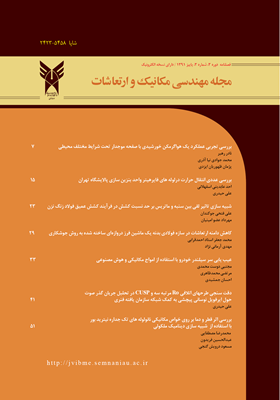دقت سنجی طرحهای اتلافی Ro مرتبه سه و CUSP در تحلیل جریان گذر صوت حول ایرفویل نوسانی پیچشی به کمک شبکه سازمان یافته فنری
محورهای موضوعی : مکانیک سیالات
1 - استادیار، گروه مهندسی مکانیک، واحد سمنان، دانشگاه آزاد اسلامی ، سمنان، ایران
کلید واژه: شبکه سازمان یافته, فنر خطی, شبکه متحرک تطبیق پذیر, طرح اتلافی مرکزیCUSP, طرح اتلافی بالادست RO,
چکیده مقاله :
در این مقاله تحلیل جریان غیر دائم گذر صوت همراه با حرکت مرز و همچنین مقایسه طرح های اتلافی اسکالر، رو مرتبه سه و کاسپ در این گونه جریان ها مورد توجه است. بدین صورت که جریان غیر دائم، دو بعدی، تراکم پذیر و غیر لزج حول یک ایرفویل نوسانی با حل معادلات اویلر روی یک شبکه سازمان یافته تطبیق پذیر بررسی می شود. برای افزایش قابلیت حرکت شبکه عددی و جلوگیری از تداخل خطوط شبکه از فنر کششی درراستای موازی سطح و عمود بر سطح استفاده شده است. همچنین از طرح اتلافی تفاضل بالادست رو (Ro) و طرح اتلافی تفاضل مرکزی CUSP برای تحلیل جریان استفاده شده است. مسئله اصلی طرح تفاضل مرکزی برای حل معادلات که به عنوان نتیجه پدیده شوک اتفاق می افتند، ناپایداری و نا پیوستگی در حل است که به علت عدم استفاده درست از اطلاعات نزدیک شوک رخ می دهد. که برای حل این مشکل از اتلافات مصنوعی استفاده شده است. با این روش حرکت ایرفویل نوسانی شبیه سازی ، شبکه آن تطبیق پذیر و اتلافات مصنوعی آن مدل شده است. سپس نتایج حاصل با نتایج تجربی مقایسه می گردد. درنهایت دقت روش های عددی بررسی می شود. نتایج نشان می دهد که دقت حل روش کاسپ در لبه فرار ایرفویل بیشتر است و همچنین شوک ایجاد شده بر روی ایرفویل را بهتر مدل می کند.
In this article, the unsteady transonic flow analysis with moving boundary is considered to compare dissipation schemes consist of: SCDS scheme, Ro 3rd order and CUSP methods. So that the unsteady, two-dimensional, non-viscous, compressible flow around an oscillating airfoil is investigated by solving Euler equations with adaptive grid network. To enhance the ability of moving grid network and prevent interference grids, linear springs are used in tangential and normal direction to the surface. Also the difference between the upwind (Ro) and the central difference CUSP dissipation scheme analysis is studied. The main problem, which occurs to the solution of equations as a result of the phenomenon of shock in central differences, is instability and non-continuity in the solution because of the lack of shock information. To solve the problem the artificial dissipation is used. In this way, the oscillating airfoil motion, the adaptive network and artificial dissipation are modeled. For validation, results are compared with experimental data. Finally, the numerical accuracy is checked. The results show that the of solving the CUSP scheme at the airfoil trailing edge and the shock capturing leads to better accuracy.


